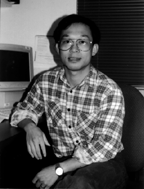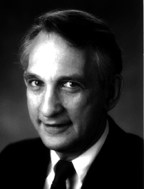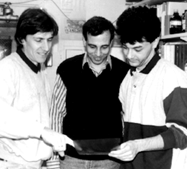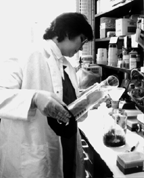
Next time you hit one of NIH's inevitable administrative glitches, imagine trying to conduct cutting edge biomedical research on a lab budget of only a few hundred dollars a month. Or figuring out how to earn a Ph.D. in molecular biology in a land where there are no molecular biology departments. Or pursuing a research career in an economic climate in which accomplished biologists aren't even paid enough to rent a decent apartment. Or attempting to fine-tune experimental designs and put data into perspective without easy access to other leading minds in the field.
For many of the approximately 2,000 foreign scientists in NIH's intramural research program, it may not take much imagining. Although American researchers are often tempted to see NIH's glass as half empty, grousing about the cramped quarters, funding pressures, and cumbersome ordering systems, most foreign scientists view NIH's glass as half full, if not overflowing, when compared with labs in their homelands. Almost to the person, foreign scientists interviewed by The NIH Catalyst say they were struck by the abundance of resources they found awaiting them at what many consider the leading biomedical research institution in the United States, if not the world.
 |
"When I came to the United States, I was moved to awe," says Yun-Bo Shi, a tenure-track NICHD scientist who trained at several U.S. institutions after arriving from China in 1983. "The facilities were so much better than they were back at home." NHLBI's Sue Goo Rhee, who came to NHLBI as a postdoc in 1973 and now is chief of NHLBI's Laboratory of Cell Signaling, says he was accustomed to building his own apparatus for distillation experiments in his native Korea.
Recent arrivals continue to be impressed. Sasha Zivkovic, a postdoc who came to NIDR in the spring of 1995 from Croatia, says, "The number one difference is resources. We were working with such a small amount of money - several hundred dollars a month for experiments. It's almost magic if you can get experiments to work with that." Even scientists from more peaceful, prosperous nations find themselves amazed by the resources that the United States devotes to biomedical research. NICHD's Hiroshi Ohno, an M.D.-Ph.D. who came to NIH from Japan on a postdoc 18 months ago, says that due to the combined pressure of relatively low funding and high costs of reagents and equipment, Japanese labs often try to save money by buying reusable pipets and glassware - glassware that must be washed by the researchers themselves. "Here (in the United States), scientists use more disposable materials because they want to use their time to do experiments, not to wash glass," Ohno says. Jolanta Redowicz, who left Poland four years ago for a postdoc at NHLBI, says that due to tight funding, her lab at the Nencki Institute for Experimental Biology in Warsaw had to plan most of its experiments out in detail nearly one year in advance to ensure that they would receive the needed equipment and reagents in time. "I was shocked at how fast you could get reagents here," says Redowicz, adding that because of low pay, most Polish biologists with families either have a spouse working in a higher-paying field or moonlight doing things like selling eggs. "American scientists don't realize how good they have it."
Another aspect of NIH life that many foreign scientists find particularly appealing is a scientific culture that encourages open communication with senior researchers. "I'm not here for the machines - I'm here for the science," says Pierre Savagner, a Ph.D.-D.V.M. who has divided his research time between NIDR and France's Centre National de la Recherche Scientifique (CNRS). "I especially like that the communication is direct and easy. Traditionally, there's been more distance among French scientists, although that's been changing over the last 10 years."
Despite their enthusiasm for NIH resources and the American approach to scientific communication, most foreign scientists are quick to acknowledge that they've encountered a few cross-cultural bumps along the pathway to becoming productive NIH scientists, with language ranking at the top of the list. "One of my big problems is English. ... Many Japanese postdocs have a complex about their language," says Ohno, adding that communication is further complicated by the fact that while most Americans value straightforward expression of thoughts and feelings, Japanese are taught not to express personal thoughts or desires.
 |
NHLBI Scientific Director Edward Korn, who has had numerous foreign scientists in his lab, beginning with a Turkish postdoc some 42 years ago, thinks many foreign scientists worry too much about their less-than-perfect English. "Language is a problem, but not an insurmountable problem," Korn says. "If someone does good science and organizes their data, tables, and figures in a logical way, it's relatively easy for an American mentor to help them turn it into a good paper. Besides, many American scientists don't write all that well, either." For those foreign scientists who would like help in fine-tuning their language skills, the Foundation for Advanced Education in the Sciences (FAES) offers courses on comprehending and speaking American English and writing a scientific manuscript (see box, page 13).
Other difficulties confronting many foreign scientists include the intricacies of getting a family settled, figuring out pay and benefit policies, and trying to iron out visa problems. At NIH, the John E. Fogarty International Center (FIC) is the place where foreign scientists can turn to for help on many such matters (see box, page 13). "Our concern is to make the entry of all foreign scientists into NIH as smooth as possible. ... American scientists should be sensitive to the toll of making such a transition," says FIC Director Philip Schambra, who is no stranger to such transitions, thanks to a postdoc he did at the Institute for Radiobiology in Karlsruhe, Germany, in the early 1960s.
Before a foreign scientist arrives at NIH, he or she receives a packet of information from FIC that covers everything from specific details about their visa status to what to do in the event of a lab injury, along with a handbook that provides information on such mundane matters as banking, apartment hunting, transportation, child care, and even shopping malls. "If people want to be happy when they come here, they have to want to discover the place. If they are only coming to get papers, they will be very unhappy," says Savagner, who counts majestic trees among the benefits of living in Bethesda as opposed to his native Paris. Besides FIC, other organizations that help to equip foreign scientists and their families for such "exploration" include the NIH & NOAA Recreation and Welfare Association (R&W), the International Women's Group, and various nationality-based groups (see boxes, page 14, 15).
 |
When people of different cultures share the same workplace, there is the potential for discrimination on the basis of those cultural differences, as was highlighted by the NIH Diversity Conference on Oct. 25-27. But none of the intramural scientists interviewed for this article reported encountering such discrimination at NIH. "I have found American scientists to be very nice. One reason is that I think they are used to having postdocs from the outside," Ohno says. "In the reverse situation - if American postdocs came to Japan - I think it would be more difficult than it is for me here." Bentzi Katz, who came to NIDR for a postdoc two years ago from Israel, finds NIH's international atmosphere a source of pleasure rather than friction. "I've learned not just about life here in the United States, but because of the wide variety of cultures and nationalities in the lab, I've learned a lot about life in Europe, Japan, around the world," Katz says. "Sure, we discuss science. But we also discuss politics and culture and current events."
At a recent meeting, some members of The NIH Fellows Committee expressed concerns that foreign postdocs and clinical associates may be being held to tougher standards than their American counterparts. However, all of the foreign scientists that The NIH Catalyst talked with expressed the opinion that internal pressure rather than external coercion is what motivates some foreign scientists to spend long hours in the lab. Xufeng Wu, a native of Shanghai, China who got a Ph.D. at Johns Hopkins University in Baltimore before coming to NHLBI two years ago, says: "Some Chinese, especially those who come directly from China, think they have to work harder to compete with other scientists. ... Because they have a language barrier and can't express themselves well, the only way they have to express themselves is to work hard." NIDR's Katz also notes that many postdocs, including himself, are driven by the desire to return to their homelands as soon as possible.
"Everything takes longer for many foreign scientists," reflects NHLBI's Rhee. "Things that are simple for American scientists, like reading and sending e-mail, can take a lot longer for people who don't have good English. And when it comes to writing manuscripts, many foreign scientists really suffer." NICHD's Shi says that another reason that foreign scientists tend to work longer hours than U.S. researchers is that "other than work, they may have few things to do" because they are in a new environment with a different cultural background and are often not accompanied by family members. He observes that scientists who come with their families and who have been in the United States longer generally are less obsessive about their work because of their outside interests and social obligations.
 |
Recently, with the heightened competition for tenure-track academic jobs in the United States, some members of the U.S. scientific and political communities have expressed concern that the growing numbers of foreign graduate students and postdocs who are coming to America for training may stay, taking jobs away from young U.S. scientists. But NHLBI's Rhee emphasizes that the need or desire for foreign scientists to stay - or even train - in the United States can change quickly, and the scientific opportunities in foreign nations can be increased by pioneers trained at NIH. When he came to the United States from Korea in the late 1960s to get his Ph.D., Rhee says it was impossible to train for or conduct a biomedical research career in Korea due to economic conditions. Although things were beginning to improve in the late 1970s, Rhee chose a tenured position at NIH over top universities in Seoul because he realized that Korea could not provide the facilities he needed to do world-class research. However, when his first four Korean postdocs returned to their homeland in the early 1980s, they were able to build solid careers in biomedical research and set up labs in which Koreans could earn Ph.D.s before heading off to the U.S. for postdoc training. "My Korean postdocs now all want to return home because the opportunities are better for them there than here. There is no reason for them to stay," says Rhee, adding that, in time, a similar progression may occur in China and other nations where biomedical research is currently a low priority. Indeed, NHLBI's Redowicz reports that in the past couple of years, the biomedical research funding situation in Poland appears to be improving. American biotech industries are setting up operations in Poland and the government has also established a new NIH-style system of research grants with relatively high funding rates for good proposals submitted by scientists at leading research institutions.
Although NIH certainly has given a lot to foreign scientists and their homelands, America's hub for biomedical research has also received much in return. "Clearly, foreign scientists contribute substantially to NIH's scientific productivity, which is of use to the international scientific community," says NHLBI's Korn. "In addition, foreigners contribute a great deal to the intellectual and cultural environment in the lab. They widen our perspectives."
| Foreign Scientists in NIH Visiting Program Top 20 Nations in FY 1994 | |||
|---|---|---|---|
| Japan | 291 | Israel | 62 |
| China | 232 | Australia | 43 |
| Italy | 135 | Argentina | 42 |
| Russia | 100 | Poland | 40 |
| South Korea | 99 | Spain | 36 |
| India | 95 | Hungary | 34 |
| France | 92 | Taiwan | 29 |
| United Kingdom | 78 | Brazil | 25 |
| Germany | 77 | Greece | 21 |
| Canada | 66 | Czech Republic | 20 |